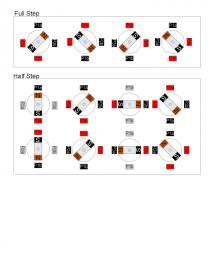I, for one, greatly appreciate the effort you put into this, Bill. I don't think the effort is wasted; I do have a suggestion for Version 2.
Consider a spectrum from "student-driven" to "teacher-driven".
Student driven:
- I (student) know what I want to learn, and (just as important) I know what I don't want to spend time on.
- Let's just ask questions. Sooner or later, every question will get asked, and we'll all know everything we want to learn.
- As we make progress, we (students) will ask better questions, and we'll help each other over the hard parts.
Teacher driven:
- There are many ways to learn a subject, some paths are far more efficient than others.
- Someone who already knows the subject, is better suited to picking the path.
This is a spectrum, between those two extremes. You don't have to pick one or the other; you have to pick somewhere in the middle that is comfortable for the greatest number of participants.
At first, especially in an online forum like this, I think students rush to ask questions and you think the process is going great. But the questions get more and more specific, and when that particular discussion is exhausted, so are the students! Everyone looks around, wondering what to do next because there's no obvious next question.
This is what happened here (i.m.h.o.). There's no one with the 50,000 foot view. A lot of time was spent covering every single side street in one neighborhood, but now we've got to head for another town, and all its neighborhoods. Here's where this discussion needs a high level road map.
Something else too: People have limited time, they have only a certain amount of attention to give. You give them lots of detail, how can that be bad? It can be bad by exhausting their attention that would be better spent on other things they want to learn.
In short, this effort needs to be
a little more teacher driven. That doesn't mean we have to find a single expert and convince them to write posts for hours and hours. But here's where an expert can help. An expert can:
- lay out the landscape (the curriculum),
- throttle the discussion when it dives too deep
- move it on to the next big topic
(When I say "throttle the discussion" I don't mean saying "Shut up now.". I mean saying "that's a detailed topic that might be interesting for some, but is not necessary for understanding what comes next. So go ahead and discuss it on a secondary thread, but it's ok for some people to ignore that secondary thread.")
Concrete example: steppers vs. servos.
50,000 foot view: They're electric motor systems that go to a commanded position. You
don't care about the differences between them when it comes to topics like writing G-code, using limit switches,.... You
will need to know something about the differences when we cover topics like cost and performance, estimating your torque requirements, symptoms of things going wrong.
5,000 foot view: We're talking about choosing your motors. Both steppers and servos are systems, with driver electronics, and sometimes other components in addition to an electric motor. Because steppers are the most economical choice for many hobbyists,
we will descend into more detail on steppers to begin with.
If you care about servos, see...
500 foot view: We're talking about how much position resolution you can get with steppers. Blah blah, microstepping, blah blah, gearing down.....
500 foot view (different neighborhood): We're talking about holding torque in steppers. Blah blah cogging, ....
5000 foot view (different town): We're talking about what goes wrong when the machine is overloaded. This is an area where servos and stepper have different behavior. ....
I hope that gives you some idea of what
might be a different way to try this again.
Disclaimer: I'm not a CNC expert. I've never built a CNC machine; I've never even operated a CNC machine. I'm simply throwing my 2 cents out there on the basis of what I read. Hope it helps in some way.





